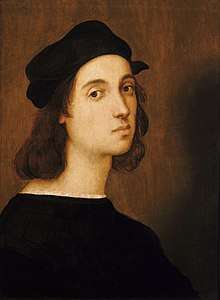Mond Crucifixion
The Mond Crucifixion (or Crocifissione Gavari; both names are after former owners) is a painting by Italian Renaissance artist Raphael, originally made up of a main panel and a two-panel predella. The main panel was bequeathed to the National Gallery by Ludwig Mond, whilst the two predella panels are in the Museu Nacional de Arte Antiga in Lisbon (St Jerome Resurrects Two Dead Men) and the North Carolina Museum of Art in the USA (The Miracle of St Jerome).
| Crucifixion with the Virgin, Saints and Angels | |
|---|---|
 | |
| Artist | Raphael |
| Year | 1502–3 |
| Type | Oil on poplar |
| Dimensions | 283.3 cm × 167.3 cm (111.5 in × 65.9 in) |
| Location | National Gallery, London |
An early work influenced by Perugino, it was originally an altarpiece in the church of San Domenico, Città di Castello, near Raphael's hometown of Urbino. The painting shows Jesus on the cross, who is looking peaceful even though he is dying. There are two angels catching his blood in chalices. On Jesus' left kneels Mary Magdalene, with John the Evangelist standing behind her. On his right Mary stands, and the holy Hieronymus is kneeling in front of her. At the foot of the cross is the inscription RAPHAEL/ VRBIN / AS /.P.[INXIT] ("Raphael of Urbino painted this") in silver letters.
Painting materials
The main panel was analyzed in the National Gallery London[1] and the typical pigments of the Renaissance period were identified. He painted the Crucifixion among other pigments with natural ultramarine, lead-tin-yellow, verdigris, vermilion and ochres[2]
References
- Roy, A., Spring, M., Plazzotta, C. ‘Raphael’s Early Work in the National Gallery: Paintings before Rome‘. National Gallery Technical Bulletin Vol 25, pp 4–35.
- Raphael, The Mond Crucifixion, ColourLex
